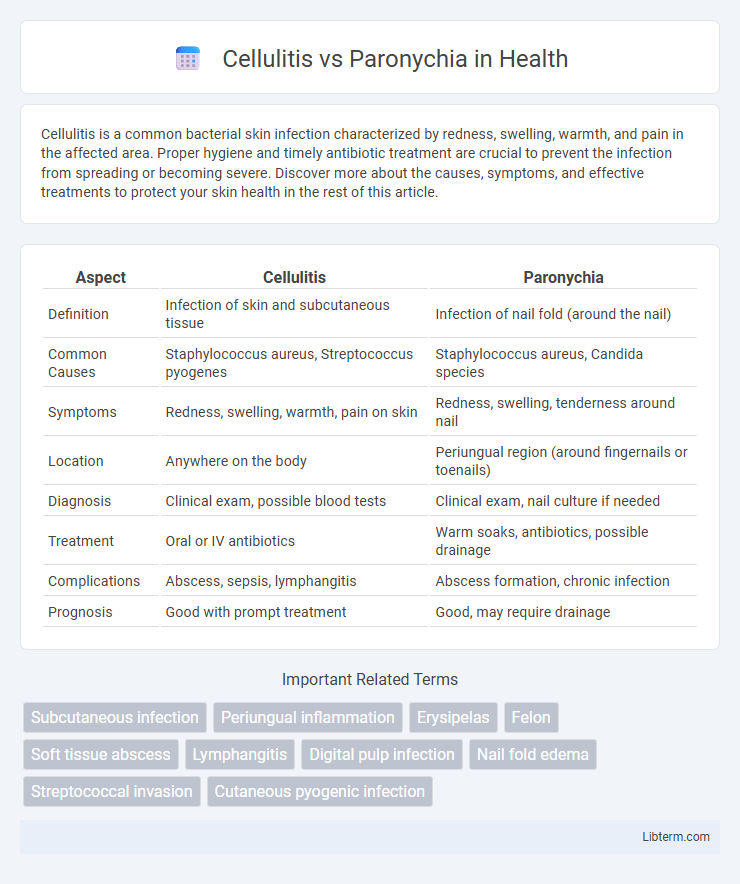Cellulitis is a common bacterial skin infection characterized by redness, swelling, warmth, and pain in the affected area. Proper hygiene and timely antibiotic treatment are crucial to prevent the infection from spreading or becoming severe. Discover more about the causes, symptoms, and effective treatments to protect your skin health in the rest of this article.
Table of Comparison
| Aspect | Cellulitis | Paronychia |
|---|---|---|
| Definition | Infection of skin and subcutaneous tissue | Infection of nail fold (around the nail) |
| Common Causes | Staphylococcus aureus, Streptococcus pyogenes | Staphylococcus aureus, Candida species |
| Symptoms | Redness, swelling, warmth, pain on skin | Redness, swelling, tenderness around nail |
| Location | Anywhere on the body | Periungual region (around fingernails or toenails) |
| Diagnosis | Clinical exam, possible blood tests | Clinical exam, nail culture if needed |
| Treatment | Oral or IV antibiotics | Warm soaks, antibiotics, possible drainage |
| Complications | Abscess, sepsis, lymphangitis | Abscess formation, chronic infection |
| Prognosis | Good with prompt treatment | Good, may require drainage |
Introduction to Cellulitis and Paronychia
Cellulitis is a common bacterial skin infection characterized by redness, swelling, warmth, and pain, often caused by Staphylococcus or Streptococcus species. Paronychia specifically affects the skin around the nails, leading to localized inflammation, tenderness, and pus formation usually due to bacterial or fungal infection. Differentiating between cellulitis and paronychia is essential for targeted treatment, as cellulitis can spread rapidly while paronychia is generally confined to the nail fold area.
Definitions and Key Differences
Cellulitis is a bacterial infection of the skin and underlying tissues characterized by redness, swelling, warmth, and pain, commonly caused by Streptococcus or Staphylococcus species. Paronychia is an infection of the skin around the nail, often involving the proximal or lateral nail folds, presenting with localized redness, swelling, and tenderness, typically caused by Staphylococcus aureus or Candida species. The key difference lies in the infection site: cellulitis affects broader skin areas and subcutaneous layers, while paronychia specifically targets the nail folds.
Causes and Risk Factors
Cellulitis is primarily caused by bacterial infections, most commonly Streptococcus and Staphylococcus species, entering through breaks in the skin, while paronychia results from bacterial or fungal infections affecting the nail folds, often due to trauma or chronic moisture exposure. Risk factors for cellulitis include compromised skin barriers such as cuts, insect bites, or eczema, and conditions like diabetes or immunosuppression that impair the immune response. In contrast, paronychia risk factors involve nail-biting, manicures, frequent hand washing, and occupations that expose hands to water and irritants, increasing susceptibility to infection.
Signs and Symptoms
Cellulitis presents with diffuse redness, warmth, swelling, and pain in the affected skin area, often accompanied by fever and chills, indicating a deeper skin infection. Paronychia is characterized by localized swelling, redness, and tenderness around the nail fold, sometimes with pus formation, typically resulting from a bacterial or fungal infection. Both conditions cause inflammation, but cellulitis affects broader skin regions while paronychia remains confined to the nail margin.
Areas of the Body Commonly Affected
Cellulitis primarily affects the skin and subcutaneous tissues, commonly occurring on the lower legs, face, and arms where breaks in the skin provide entry points for bacteria. Paronychia specifically involves the periungual tissue surrounding the fingernails and toenails, often resulting from trauma or infection near the nail folds. Both conditions cause localized inflammation but target distinct anatomical regions with different clinical implications.
Diagnostic Approaches
Diagnostic approaches for cellulitis primarily involve clinical examination of erythema, warmth, swelling, and tenderness, supported by blood cultures or imaging if systemic involvement is suspected. Paronychia diagnosis focuses on localized inflammation around the nail fold, with needle aspiration or culture of purulent material aiding in identifying bacterial or fungal pathogens. Both conditions rely on patient history and physical findings to differentiate cellulitis spreading on skin from paronychia limited to nail tissue.
Treatment Options
Treatment options for cellulitis primarily include systemic antibiotics such as cephalexin, dicloxacillin, or clindamycin, targeting common bacteria like Streptococcus and Staphylococcus species. Paronychia management depends on whether it is acute or chronic; acute cases often require warm soaks, topical or oral antibiotics like mupirocin or cephalexin, and possible incision and drainage for abscesses. Chronic paronychia may benefit from antifungal treatments, corticosteroids, and avoidance of irritants to reduce inflammation and prevent recurrence.
Complications and Prognosis
Cellulitis can lead to serious complications such as abscess formation, sepsis, and chronic lymphedema if untreated, while paronychia risks include abscess development and nail deformities. Prognosis for cellulitis is generally good with prompt antibiotic therapy, but delayed treatment increases morbidity. Paronychia often resolves with proper drainage and antibiotics, yet recurrent infections may cause permanent nail damage.
Prevention Strategies
Preventing cellulitis involves maintaining proper skin hygiene, promptly treating wounds, and managing chronic conditions like diabetes that increase infection risk. For paronychia, avoiding nail trauma, keeping hands dry, and refraining from biting or picking the nails are key preventive measures. Both conditions benefit from protective gloves during activities exposing the hands to moisture or irritants.
When to Seek Medical Attention
Seek medical attention immediately for cellulitis if you experience rapidly spreading redness, severe pain, fever above 101degF (38.3degC), or swollen lymph nodes, as it can lead to serious complications like sepsis. For paronychia, urgent care is necessary when there is intense pain, pus formation, red streaks spreading from the finger or toe, or if the infection does not improve within a few days of home treatment. Timely diagnosis and treatment with appropriate antibiotics or drainage are crucial to prevent worsening infection in both cellulitis and paronychia.
Cellulitis Infographic

 libterm.com
libterm.com